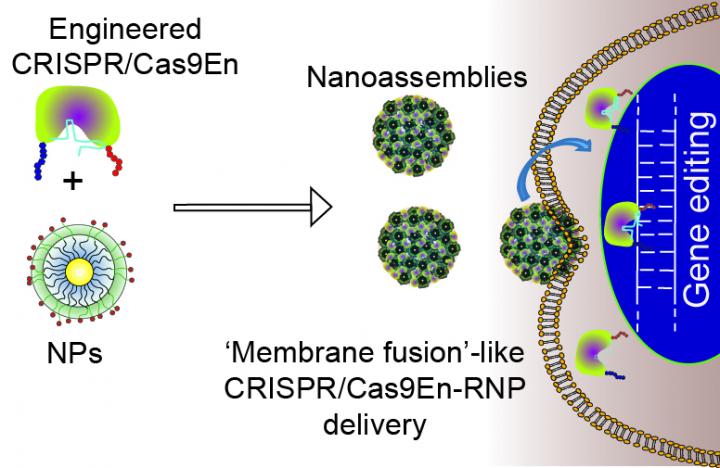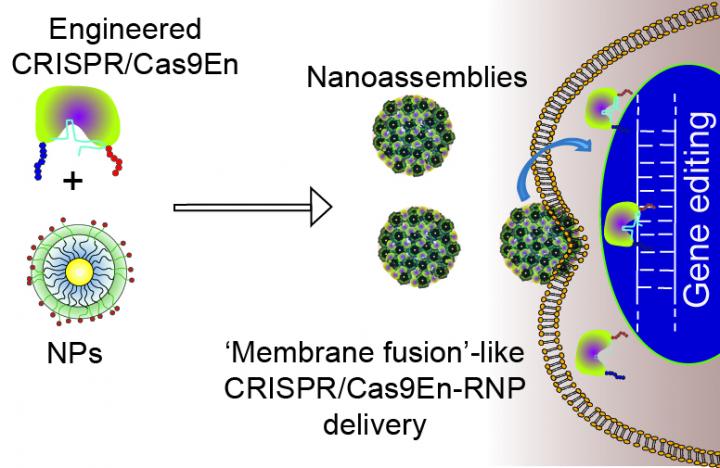
Credit: UMass Amherst
AMHERST, Mass. – More and more scientists are using the powerful new gene-editing tool known as CRISPR/Cas9, a technology isolated from bacteria, that holds promise for new treatment of such genetic diseases as cystic fibrosis, muscular dystrophy and hemophilia. But to work well, the new gene-clipping tool must be delivered safely across the cell membrane and into its nucleus, a difficult process that can trigger the cell's defenses and "trap" CRISPR/Cas9, greatly reducing its treatment potential.
Now, researchers in nanochemistry expert Vincent Rotello's laboratory at the University of Massachusetts Amherst have designed a delivery system using nanoparticles to assist CRISPR/Cas9 across the membrane and into the cell nucleus while avoiding entrapment by cellular machinery. Details appear in a recent issue of the journal ACS Nano.
The lab's experiment leader, Rubul Mout, says, "CRISPR has two components: a scissor-like protein called Cas9, and an RNA molecule called sgRNA that guides Cas9 to its target gene. Once the Cas9-sgRNA pair gets to the destination gene in the nucleus, it can interrogate its genetic mistakes and correct them with the help of the host cell's repair machinery."
He points out that since CRISPR's potential was first discovered in 2012, gene editing or genome engineering has quickly become an intense research topic in biology and medicine. The goal is to treat otherwise incurable genetic diseases by manipulating diseased genes. "However, to achieve this, biotech and pharmaceutical companies are constantly searching for more efficient CRISPR delivery methods," he adds.
The new delivery method Rotello, Mout and colleagues designed involves engineering the Cas9 protein, named Cas9En, and carrier nanoparticles. Rotello says, "By finely tuning the interactions between engineered Cas9En protein and nanoparticles, we were able to construct these delivery vectors. The vectors carrying the Cas9 protein and sgRNA come into contact with the cell membrane, fuse, and release the Cas9:sgRNA directly into the cell cytoplasm."
"Cas9 protein also has a nuclear guiding sequence that ushers the complex into the destination nucleus. The key is to tweak the Cas9 protein," he adds. "We have delivered this Cas9 protein and sgRNA pair into the cell nucleus without getting it trapped on its way. We have watched the delivery process live in real time using sophisticated microscopy."
Mout and colleagues say they can now deliver the Cas9 protein and sgRNA pair into about 90 percent of cells grown in a culture dish with an editing efficiency of about 30 percent. "Ninety percent cytosolic/nuclear delivery is a huge improvement compared to others methods," Mout points out.
The researchers believe that the Cas9En may also serve as a platform for delivery of a variety of other materials such as polymers, lipid nanoparticles or self-assembling peptides. Rotello says, "Now that we have achieved efficient gene editing in cultured cells, we are aiming to edit genes in pre-clinical animal models. We are also interested in gene editing for adoptive therapies, where a diseased cell is isolated from a patient, corrected by CRISPR in the lab, and delivered back to the patient."
Apart from gene editing, the new delivery method may have other uses. For example, another important issue in biology and medicine is tracking DNA and RNA inside cells. Recently, CRISPR has been used to aid in this research. Moumita Ray, another researcher in the Rotello lab, says, "Our method allows the precise monitoring of Cas9 protein movement inside a cell, opening new opportunities in genomic research."
###
Media Contact
Janet Lathrop
[email protected]
413-545-0444
@umassscience
http://www.umass.edu
############
Story Source: Materials provided by Scienmag





